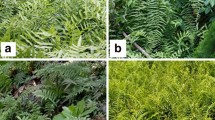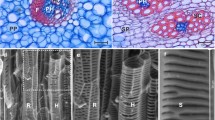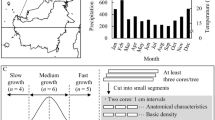Abstract
Secondary xylem characteristics and horizontal variations were described in three xerophytic species, Zygophyllum xanthoxylon, Nitraria tangutorum, Tetraena mongolica of Zygophyllaceae native to western China. All the species have obvious growth ring boundaries except sometimes discontinuous in T. mongolica and Z. xanthoxylum ring to semi-ring-porosity; simple perforation plate; alternate intervessel pitting; non-septate fibres; paratracheal confluent axial parenchyma; helical thick enings and heterocellular rays. However the vessel arrangement and quantitative features of vessels were different. Vessel elements tend to be shorter and narrower and more frequent in T. mongolica than in other two species that are hardly different could lead to greater conductive safety. The variation of vessel element length and fibre length along radial direction showed irregular tendency. There was significant difference in both fibre length and vessel element length among-tree and within-tree. Furthermore, the relationships between anatomical features and adaptability to desert environments were also discussed.
Similar content being viewed by others
References
Baas, P. 1986. Ecological patterns in xylem anatomy [C]. In: T. J. Givnish (ed.), On the economy of plant form and function. Proceeding (11): 327–352. Cambridge, London, New York, New Rochelle, Melbourne, Sydney: Cambridge Univ. Press.
Baas, P., Schweingruber, F.H. 1987. Ecological trends in the wood anatomy of trees, shrubs and climbers from Europe [J]. IAWA Bull. n. s. 8(3): 245–274.
Baas, P., Esser, P.M., Van der Western, M.E.T., Zandee, M. 1988. Wood anatomy of Oleaceae [J], IAWA Bull.n.s. 9: 103–182.
Carlquist, S. 1966. Wood anatomy of Compositae: a summary with comments on factors controlling wood evolution [J]. Aliso, 6: 25–44.
Carlquist, S. 1975. Ecological strategies of xylem evolution [M]. Berkeley, Los Angeles, London: Univ. Calif. Press.
Carlquist, S. 1977. Ecological factors in wood evolution: a floristic approach [J]. Amer. J. Bot., 64: 887–896.
Carlquist, S. 1982. Wood anatomy of Illicium (Illiciaceae): phylogenetic, ecological, and functional interpretation [J]. Amer. J. Bot., 69: 1587–1598.
Carlquist, S. 1984. Vessel grouping in dicotyledon wood: significance and relationship to imperforate tracheary elements[J], Aliso, 10:505–525.
Carlquist, S, Hoekman, D.A. 1985. Ecological wood anatomy of the woody southern Californian flora [J]. IAWA Bull. n. s., 6(4):319–347.
Carlquist, S. 1988. Comparative wood anatomy. Systematic, ecological, and evolutionary aspects of dicotyledon wood. Berlin: Springer-Verlag.
Carlquist, S. 1992. Wood anatomy in Solanaceae: a survey [J]. Allertonia, 6: 279–326.
Exley, R.R, Meylan B.A, Butterfield, B.G. 1977. A technique for obtaining cut surfaces on wood samples prepared for the scanning electron microscope [J]. J. Microscopy, 110: 75–78.
Fahn, A., Werker, E, Baas, P. 1986. Wood anatomy and identification of trees and shrubs from Israel and adjacent regions. Israel Academy of Sciences, Jerusalem, Israel.
IAWA COMMITTEE. 1989. IAWA list of microscopic features for hardwood identification. IAWA Bull. n. s., 10: 219–332.
Lindorf, H. 1994. Eco-anatomical wood features of species from a very tropical forest. IAWA Journal, 15(4): 361–376.
Lindorf, H. 1997. Wood and leaf anatomy in Sessea corymbiflora from an ecological perspective [J]. IAWA Journal, 18(2):157–168.
Schweingruber, F.H. 1990. Anatomy of European woods, Haupt. 259.
Villagra, P.E, Roig Junen, F.A. 1997. Wood structure of Prosopis alpataco and P. argentina growing under different edaphic conditions [J]. IAWA Journal, 18(1): 37–51.
Woodcock, D.W. 1994. Occurrence of woods with a gradation in vessel diameter across a ring [J]. IAWA Journal, 15(4): 377–385
Zhong, Y., Baas, P., Wheeler, E.A. 1992. Wood anatomy of trees and shrubs from China. IV. Ulmaceae. IAWA Bull. n. s. 13(4): 419–453
Zimmermann, M.H., Brown, C.L. 1971. Trees, structure and function. Springer-Verlag, Berlin, Heidelberg, New York.
Zimmermann, M.H., Brown, C.L. 1977. Trees: Structure and function [M]. New York: Springer-Verlag.
Zimmermann, M.H. 1982. Functional xylem anatomy of angiosperm trees. In: new perspectives in wood anatomy, 59–70. Nijhoff/Junk, The Hague, Boston.
Zimmermann, M.H. 1983. Xylem structure and ascent of sap [M]. Berlin, Heidelberg, New York, Tokyo: Springer-Verlag.
Author information
Authors and Affiliations
Additional information
Biography: YANG Shu-min (1971), female, Ph. D. Lecture in the Research Institute of Wood Industry, Chinese Academy of Forestry, Beijing, 100091, P. R. China.
Rights and permissions
About this article
Cite this article
Yang, Sm., Furukawa, I. Anatomical adaptations of three species of Chinese xerophytes (Zygophyllaceae). J. of For. Res. 17, 247–251 (2006). https://doi.org/10.1007/s11676-006-0056-7
Received:
Accepted:
Issue Date:
DOI: https://doi.org/10.1007/s11676-006-0056-7




